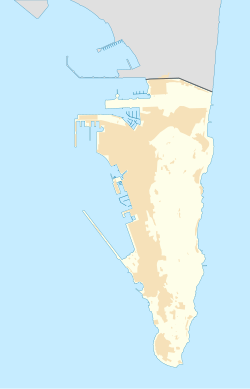
The Western Heights of Dover are one of the most impressive fortifications in Britain. They comprise a series of forts, strong points and ditches, designed to protect the country from invasion. They were created in the 18th and 19th centuries to augment the existing defences and protect the key port of Dover from both seaward and landward attack; by the start of the 20th century Dover Western Heights was collectively reputed to be the 'strongest and most elaborate' fortification in the country. The Army finally withdrew from the Heights in 1956-61; they are now a local nature reserve.

Shornemead Fort is a now-disused artillery fort that was built in the 1860s to guard the entrance to the Thames from seaborne attack. Constructed during a period of tension with France, it stands on the south bank of the river at a point where the Thames curves sharply north and west, giving the fort long views up and downriver in both directions. It was the third fort constructed on the site since the 18th century, but its location on marshy ground led to major problems with subsidence. The fort was equipped for a time with a variety of large-calibre artillery guns which were intended to support two other nearby Thamesside forts. However, the extent of the subsidence meant that it became unsafe for the guns to be fired and the fort was disarmed by the early 20th century.

Europa Point, is the southernmost point of Gibraltar. At the end of the Rock of Gibraltar, the area is flat and occupied by such features as a playing field and a few buildings. On a clear day, views of North Africa can be seen across the Strait of Gibraltar including Ceuta and the Rif Mountains of Morocco; as well as the Bay of Gibraltar and the Spanish towns along its shores. It is accessed from the old town by Europa Road.

The North Bastion, formerly the Baluarte San Pablo was part of the fortifications of Gibraltar, in the north of the peninsula, protecting the town against attack from the mainland of Spain. The bastion was based on the older Giralda tower, built in 1309. The bastion, with a mole that extended into the Bay of Gibraltar to the west and a curtain wall stretching to the Rock of Gibraltar on its east, was a key element in the defenses of the peninsula. After the British took Gibraltar in 1704 they further strengthened these fortifications, flooding the land in front and turning the curtain wall into the Grand Battery.

King's Bastion is a coastal bastion on the western front of the fortifications of the British overseas territory of Gibraltar, protruding from the Line Wall Curtain. It is located between Line Wall Road and Queensway and overlooks the Bay of Gibraltar. It played a crucial role in defending The Rock during the Great Siege of Gibraltar. In more recent history the bastion was converted into a generating station which powered Gibraltar's electricity needs. Today it continues to serve the community as Gibraltar's leisure centre.

Buena Vista Battery was an artillery battery near the Buena Vista Barracks at the southern end of the British Overseas Territory of Gibraltar. It is located on a slight ridge in front of the nearby Buena Vista Barracks, which was once the base of the Royal Gibraltar Regiment.
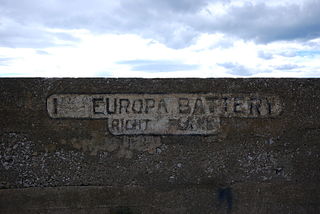
The Europa Batteries are a group of artillery batteries in the British Overseas Territory of Gibraltar. Facing the North African coast, they are the most southerly batteries in Gibraltar and were built to cover ships approaching from the Mediterranean Sea. They run along the fortified clifftops of Europa Point from Camp Bay on the west side of the Rock of Gibraltar to the Europa Advance Batteries on the east side.
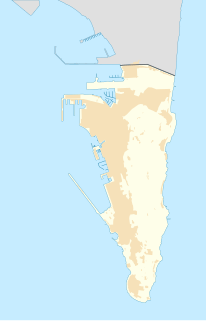
Victoria Battery was an artillery battery in the British Overseas Territory of Gibraltar. It was notable for being one of the two batteries in Gibraltar to mount a 100-ton gun.

Europa Advance Batteries were a group of three artillery batteries in the British Overseas Territory of Gibraltar. They are located north east from Europa Point.
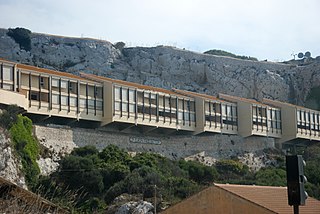
Europa Pass Batteries are a group of artillery batteries in the British Overseas Territory of Gibraltar. They are located north west of Europa Point in the south of Gibraltar, just off Europa Road.
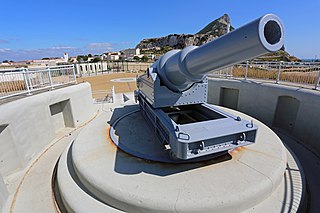
Harding's Battery is a restored artillery battery in the British Overseas Territory of Gibraltar. It is located at Europa Point and includes the Europa Sunken Magazine that is now used as a visitor centre.

Cumberland Flank Battery was an artillery battery in the British Overseas Territory of Gibraltar.

Eliott's Battery was an artillery battery in the British Overseas Territory of Gibraltar. The battery is located in front of the Officer's Barracks at Europa Flats between Prince George's Battery and Woodford's Battery. The battery is named after George Augustus Eliott, 1st Baron Heathfield, Governor of Gibraltar 1777–1790.

Half Way Battery was an artillery battery in the British Overseas Territory of Gibraltar. The battery was on the coast on the eastern side of the isthmus just north of Europa Point Lighthouse. In 1859 there were two guns.

The fortifications of Gibraltar have made the Rock of Gibraltar and its environs "probably the most fought over and most densely fortified place in Europe, and probably, therefore, in the world", as Field Marshal Sir John Chapple has put it. The Gibraltar peninsula, located at the far southern end of Iberia, has great strategic importance as a result of its position by the Strait of Gibraltar where the Mediterranean Sea meets the Atlantic Ocean. It has repeatedly been contested between European and North African powers and has endured fourteen sieges since it was first settled in the 11th century. The peninsula's occupants – Moors, Spanish, and British – have built successive layers of fortifications and defences including walls, bastions, casemates, gun batteries, magazines, tunnels and galleries. At their peak in 1865, the fortifications housed around 681 guns mounted in 110 batteries and positions, guarding all land and sea approaches to Gibraltar. The fortifications continued to be in military use until as late as the 1970s and by the time tunnelling ceased in the late 1960s, over 34 miles (55 km) of galleries had been dug in an area of only 2.6 square miles (6.7 km2).

The Windmill Hill Batteries are a series of artillery batteries situated on Windmill Hill, Gibraltar near the south of the peninsula. They are part of the fortifications of Gibraltar. The batteries were originally established by Lt General Edward Cornwallis during his governorship of Gibraltar between 1762–77, built on the site of the old windmills after which the hill was named. The singular Windmill Hill Battery refers to one particular battery almost equidistant between Genista Battery and Europa Advance Battery.

The Defensible Barracks is a fortified barracks located at Europa Flats in the British Overseas Territory of Gibraltar.

The Retrenched Barracks was a fortified barracks located at Windmill Hill in the British Overseas Territory of Gibraltar. It stands to the north of the southern tip of Gibraltar, Europa Point, which was long felt to be potentially vulnerable to a surprise attack from the sea and was heavily fortified with gun batteries, perimeter walls and scarped cliffs.
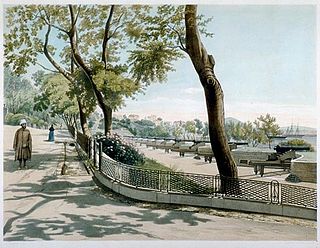
Victoria Battery was an artillery battery in the British Overseas Territory of Gibraltar. It was built in the 1840s on top of the earlier Princess of Wales Batteries following a report by Major-General Sir John Thomas Jones on Gibraltar's defences. The battery was located on the west side of Gibraltar and was one of a number of "retired" batteries in the territory, constructed to improve the coastal defences between Europa Point and the town.
